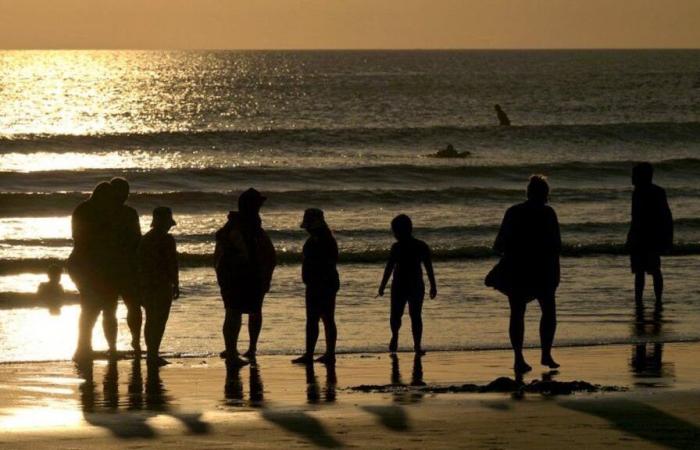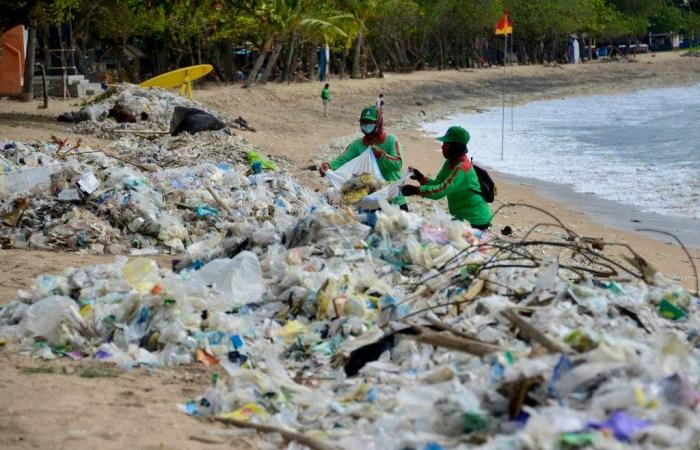More and more foreign tourists are coming to enjoy Indonesian beaches.
AFP
Tired of the mass tourism on which they are nevertheless dependent, the inhabitants of the Indonesian island of Bali aspire to more calm and serenity with a break from tourist projects.
Before it was discovered by foreign surfers, Canggu in southern Bali was a green and peaceful seaside village surrounded by rice fields. Now this town is filled with hotels and its streets are constantly clogged with cars, scooters and trucks.
The authorities have announced a plan to freeze the construction of hotels, villas and nightclubs for two years, which should restore some tranquility on the Hindu island. Provided it is applied.
“Canggu is more lively now… its tranquility and greenery are gradually disappearing,” laments Kadek Candrawati, 23. Like other residents, she believes action is needed given the drastic changes Canggu is experiencing. “The government and the community must work together to ensure that Bali remains green, has a sustainable future, and that the local culture is preserved,” continues the young woman, owner of a motorcycle rental store which earns her seven million rupees (around 390 francs) per month.
Nearly three million visitors
The rice fields of Bali are very famous.
IMAGO/Depositphotos
With its lush vegetation, rice fields and beaches popular with surfers, Bali, which offers luxury resorts and backpacker haunts, is seeing increasing numbers of tourists. The island attracted nearly three million foreign visitors in the first half of the year, most from Australia, China and India, according to official statistics.
Sandiaga Uno, Minister of Tourism until last month, had indicated that the freeze plan, whose objective is to prevent the development of massive new infrastructure in tourist areas, would be implemented during the mandate of new President Prabowo Subianto, without setting a date. A light rail system is also planned to facilitate traffic on the island.
A second airport is planned
However, Prabowo Subianto’s statements cast doubt on his desire to stop the accelerated development of Bali. During a meeting with local leaders, he promised a second international airport, in order to make Bali “the future Singapore, the future Hong Kong… an economic center”.
For Indonesian environmental group Walhi, it is already too late. “Bali is now way too built up, green spaces are becoming urbanized,” says its executive director, Made Krisna Dinata. “The proposed moratorium should be legislation that not only stops development but also protects land,” he adds. The damage to Bali’s natural beauty is already visible.
“Demand is increasing”
Still, not everyone is in favor of a break. I Gusti Ngurah Rai Suryawijaya, vice president of the Bali Hotel and Restaurant Association, is calling for further investigation before taking steps that could harm Balinese people who rely on tourism.
“When there is too much supply, a moratorium is acceptable in order to reduce competition, but at the moment, demand is increasing.” “Our occupancy rate reaches 80 to 90%,” he notes.
A tide of plastic waste regularly overwhelms Bali’s beaches, while overexploitation of groundwater has dried up more than half of its rivers. Mass tourism also threatens its traditional irrigation system, a UNESCO World Heritage Site, which feeds the rice fields, as the green areas that collect water are covered with construction.

Plastic waste, a real scourge of Indonesian beaches.
AFP
Recently, videos that went viral showed blocks of limestone falling into the sea, as a result of cliffs being excavated to build villas in the south of the island. “Many surf instructors have lost their income, customers no longer want to surf because of the dirt in the water,” laments Piter Panjaitan, a 42-year-old surfer.
Bad behavior by tourists is another factor of exasperation for locals, notably incidents in which foreigners have posed naked in sacred sites in defiance of traditions and prohibitions. “There are lots of problems with those who come here,” continues Piter Panjaitan.
(afp)








